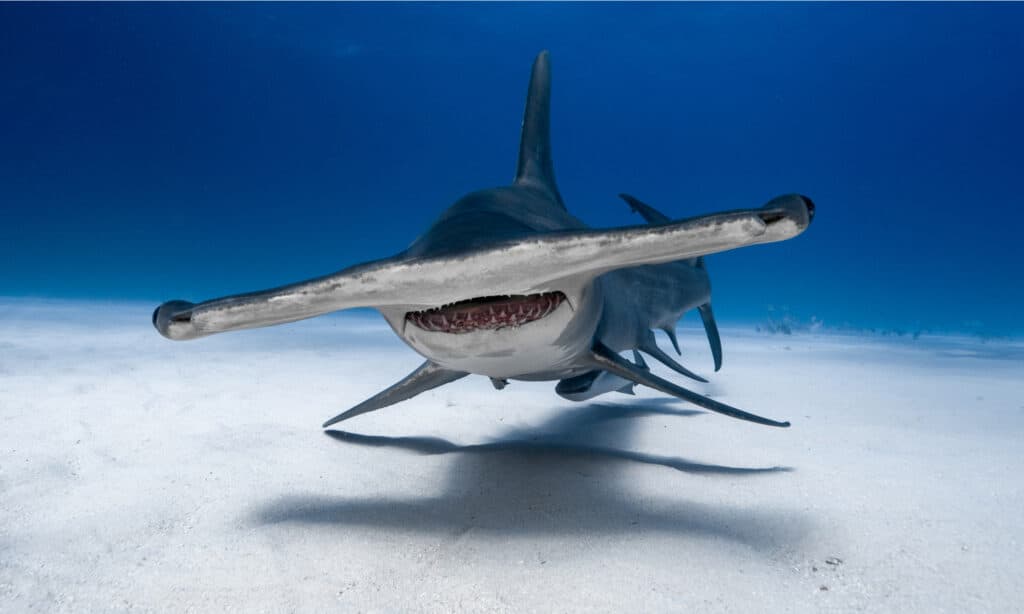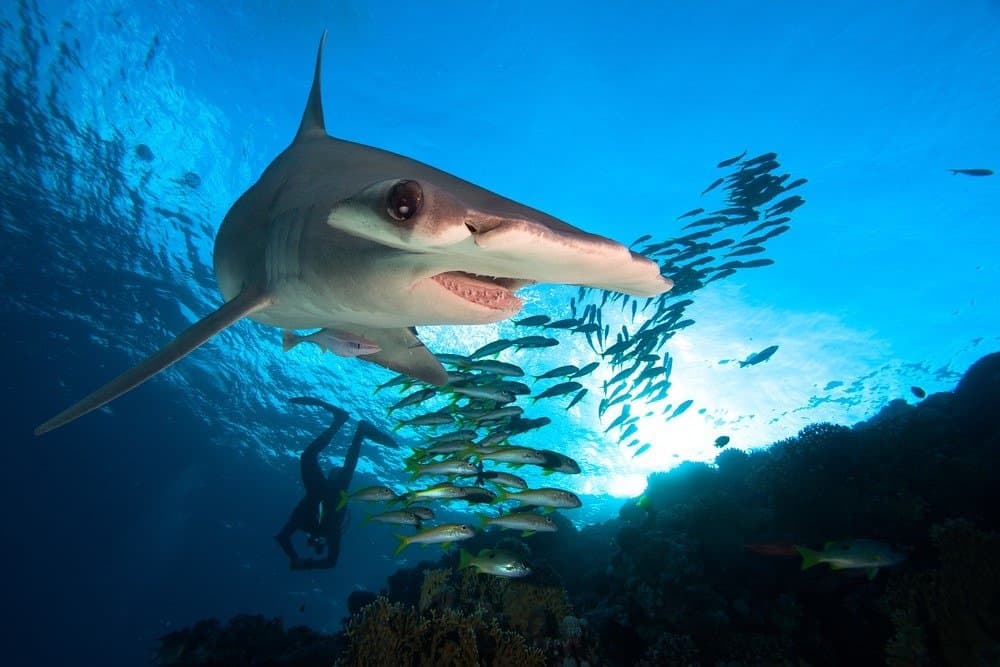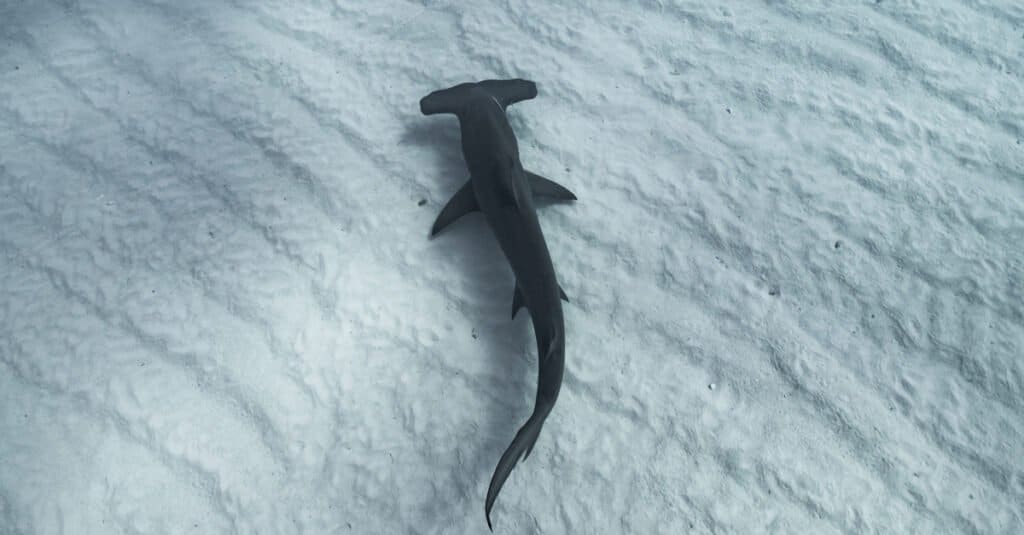Legends of monstrous hammerhead sharks off Florida’s coast have permeated local culture for decades. Tales of these gargantuan fish have drawn sports fishermen and tourists alike. Some visit Florida to see the Florida Everglades and maybe a Burmese python, but others visit to view, or fish, the schools of native hammerhead sharks. Hammerhead sharks are globally endangered, so it’s more important than ever that we act to understand and conserve these incredible creatures. Otherwise, future generations will never get the chance to see the biggest hammerheads ever caught off Florida.
Here, we’ll find out just how big the biggest hammerhead ever caught off Florida really was. Then, we’ll explore a few more cases of giant hammerheads caught off the coast. We’ll learn more about hammerheads and why there’s never been a single fatal hammerhead shark attack on a human.
The Biggest Hammerhead Sharks in Florida

Sphyrna mokarran, the great hammerhead, is the largest species of hammerhead shark.
©Sail Far Dive Deep/Shutterstock.com
Great hammerheads grow up to 20 feet long and can weigh well over 1,000 pounds. They’re thought to live for around 20-30 years, though some scientists believe they may live 50 or more years. Great hammerheads have very large, angular cephalofoils (the name given to their uniquely shaped heads). These sharks live in coastal waters all over the world. Despite their great size, there have been zero human fatalities attributed to great hammerhead sharks.
Are there Other Species of Hammerhead Shark?
Florida is home to an astounding array of wildlife, both on land and at sea. There are four native species of hammerhead, including the great hammerhead. The smaller varieties include smooth hammerheads, scalloped hammerheads, and bonnethead sharks. Only the great hammerhead grows to incredible sizes.
Why are Hammerhead Heads Shaped Like That?

Out of all the fish in the world’s oceans, hammerheads are some of the most unique.
©frantisekhojdysz/Shutterstock.com
Hammerhead sharks are incredible predators, all thanks to their heads. The cephalofoil of a hammerhead is actually made up of an array of incredible sensory equipment that allows them to detect even the smallest movement. Hammerhead sharks can even sense fish buried in the sand. And, having their eyes so far from their heads gives them a 360-degree field of vision.
Florida’s Biggest Ever Hammerhead
The largest hammerhead shark ever caught off Florida was a 1280-pound adult fished in 2006 off Boca Grande. Large hammerheads are common in the area. They’re drawn there to feed on tarpon during their spring and summer runs up the Gulf of Mexico. In fact, the last three record-breaking giant hammerheads all came from Boca Grande Pass, according to the International Game Fish Association (IGFA).
In 2019, a sport fisherman accidentally caught another monstrous hammerhead shark. As the fisherman and his friend reeled in a small blacktip reef shark, a much larger hammerhead shark came along and latched onto the hooked reef shark. With no other choice, the fishermen reeled in what ended up being a 14.7-foot-long hammerhead. It was one of the biggest hammerheads ever caught off Florida!
Are Hammerhead Sharks Dangerous?

Even the largest hammerhead sharks are generally considered docile but will bite in self-defense if threatened.
© EDGAR PHOTOSAPIENS/Shutterstock.com
Most hammerhead sharks are small and pose no threat to humans. But, some, like the biggest hammerhead ever caught off Florida, grow to monumental sizes, with mouths that are certainly big enough to kill a human. However, there have never been any fatal encounters between hammerhead sharks and humans. There are a few reasons for this. First, humans don’t fit hammerhead sharks’ prey image, that is, the sensory definition of what is good for eating and what isn’t. Also, hammerheads are generally placid fish with little interest in humans.
Why are Hammerhead Sharks Important?
Sharks are apex predators, and they’re also keystone species. Hammerhead sharks are no exception, but just what is a keystone species? A keystone species is one that is especially important to the food web, as well as to global marine ecological health. This is because, without hammerhead sharks, a vital component of the food web would disappear, throwing every other part of the web into chaos.
The biggest hammerhead shark ever caught off Florida is a perfect example of why these fish are so important to Floridians. They’re an iconic species, with some even attaining legendary status, as with the story of ‘Old Hitler,’ a legendary mythical hammerhead.
What Challenges do Hammerhead Sharks Face?

Globally, shark populations have declined, largely due to the demand for shark fin soup.
©Michael_19/Shutterstock.com
Hammerhead sharks live in warm, shallow, tropical, and subtropical waters all over the world. Unfortunately, their proximity to humans, and their docile nature, makes them easy targets for fisherman. Today, the biggest threats to hammerheads are overfishing, pollution, ocean acidification, and the practice of finning.
Hammerhead sharks are caught and ‘finned’ by fishermen who then sell the fins as ingredients in traditional Chinese medicine. Or, more popularly, as the main ingredient in shark fin soup. The practice of finning involves pulling the shark onboard, cutting off its dorsal and pectoral fins, and throwing it back into the ocean to bleed to death. The massive demand for shark fin soup has led to a severe population drop in hammerhead shark populations around the world.
How to Help Hammerhead Sharks
In order to conserve hammerheads like the biggest hammerhead ever caught off Florida, it’s important to educate yourself. The more you learn about sharks, the more you’ll realize that they’re not the demons of the sea they’re made out to be. And they’re incredibly important to the health of our marine ecosystems. Further, work to use fewer plastics, especially single-use plastics, as these frequently end up in our oceans. Who knows, maybe one day you’ll get to swim with a hammerhead or two if you haven’t already.
The photo featured at the top of this post is © Brent Barnes/Shutterstock.com
Thank you for reading! Have some feedback for us? Contact the AZ Animals editorial team.






